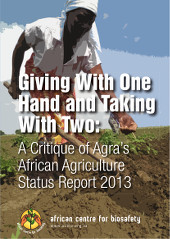The section on seed is highly problematic and of the greatest concern in the whole report. Although there is recognition of diversity and plurality in seed systems on the continent,
AGRA’s orientation is towards commercial production. It therefore calls for the introduction of commercial seed systems, with the ‘ideal’ presented as a concentrated system where a few large companies control seed R&D, production and distribution (p.56). Seed system diversity in Africa is seen as a weakness and as an obstacle to be overcome (p.56).
According to the report, weak seed production and distribution throughout the continent hinders the uptake of varieties developed through the formal R&D system (p.54). The catch, as AGRA recognises, is that in order for commercial seed companies to invest in R&D, they first want to protect their ‘intellectual property’. This requires fundamental restructuring of seed laws to allow for certification systems that not only protect certified varieties, but also actually criminalise all non-certified seed. This is a serious threat to African seed systems and the agro-biodiversity, as the African Centre for Biosafety and the Alliance for Food Sovereignty in Africa have indicated in recent publications and releases. AGRA is working with governments and other international and private entities to ‘harmonise’ seed laws across the continent, to put in place the institutional systems and structures that will allow private seed companies to control seed.
AGRA is aggressively supporting the transformation of African seed systems toward a commercially viable business model, which restricts farmers from recycling protected seed or using it to improve their local varieties. This is being done through proactive support for the seed harmonisation process in sub-Saharan Africa, which is pushing African governments to join the International Union for the Protection of New Varieties of Plants (UPOV) 1991. The report deals with genetic modification (GM) only in passing. The report defends GM as rigorously tested, citing industry and government bodies that share the modernisation paradigm as evidence. It reduces public opposition to GM to “fear of the unknown” (p.64-65). Although AGRA currently is not directly involved in sponsoring GM activities, the Bill and Melinda Gates Foundation, one of AGRA’s founders and primary sponsors, invests heavily in GM R&D on the continent and owns shares in Monsanto.
The section on financing shows that most investment in African agriculture comes from farmers themselves. Despite their own declarations, national governments generally
continue to invest less than the 10% of gross domestic product (GDP) called for in the Maputo Declaration of 2003. AGRA’s solution is for the state to guarantee loans made to
farmers; i.e. the public sector would carry private sector risk.
On output markets, AGRA reviews the experience with warehouse receipt systems (WRS) and agricultural commodity exchanges as two key commercial market mechanisms. WRS operate by allowing farmers to store their grain in warehouses for a fee, but be paid upfront for a portion of the value of the crop. Commodity exchanges allow for hedging that can stabilise prices and reduce risk (although they can also be conduits for speculation and increased volatility if institutional investors trading in derivatives dominate the market). The experience so far is not of great success. AGRA provides a number of reasons for this, most of which relate to regulation and sequencing of interventions. AGRA assigns a major role to the state in regulating and underwriting these systems.
On farmer organisation, AGRA recognises the fundamental importance of farmer organisation, but tends to focus on organisational activities to support commercialisation of production: providing members with services, enhancing collective bargaining power through aggregation and economies of scale, and enhancing farmer participation in processes affecting them (p.114). While these are important issues for farmer organisations to deal with, there may be other issues facing those members not oriented primarily to commercial production.
There are small sections in the report on capacity development, extension services and women. These tend to give an overview of the state of affairs (limited reach and limited support that is not always appropriate to context), and they make very broad recommendations about the need to increase capacity and numbers, and for women to have more access.
Section II of the report provides a number of macro-level statistics that need to be treated with caution. Collection of statistics has always been weak in African agriculture and AGRA recognises that this continues today.
It is not surprising that AGRA ignores agro-ecology given its devotion to capitalist modernisation based on Green Revolution technologies and commoditised output markets as the only answer to the question of farm productivity.
Concluding comments
AGRA is carving out its niche in African agriculture, targeting commercial or potentially commercial farmers; i.e. those who produce primarily for the market, with their agricultural operations structured as a business. There can be no argument that commercial African farmers should be supported to sell into markets. However, there are many other producers critical to food security in Africa who will not receive support from the AGRA/modernisation project. Other forms of support must be provided for these farmers. In addition, some of AGRA’s interventions (e.g. seed harmonisation) have a directly negative effect on the ability of these marginalised farmers to improve their conditions of existence, by placing regulatory and legal obstacles in the way of farmer innovation and knowledge and resource sharing.
AGRA’s project relies heavily on the state to secure the basic institutional and infrastructural frame for commercialisation. The state provides resources to secure the conditions for private extraction of wealth. This orients public resources away from other potential uses, including resources explicitly directed towards ecological agriculture, and building up and enhancing farmers’ existing practices.
The alternative ecological agriculture/food sovereignty perspective emerges very clearly from this analysis. First, start from where farmers are, building up existing practices that do not rely so heavily on external capital-intensive production processes. Seed and soil fertility systems may not be ideal, but there is a strong base to work from to improve them,
together with farmers. Second, public resources should be channelled into supporting this agenda, rather than on securing the conditions for private extraction of the value created by African farmers.

 Download 2.50 Mb
Download 2.50 Mb